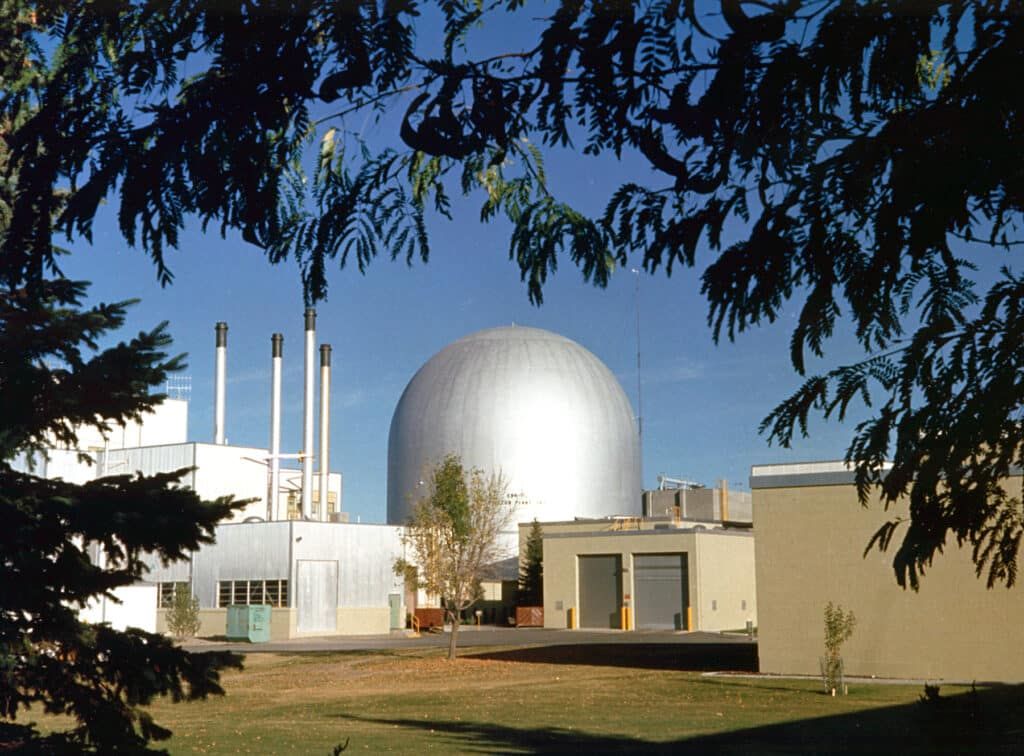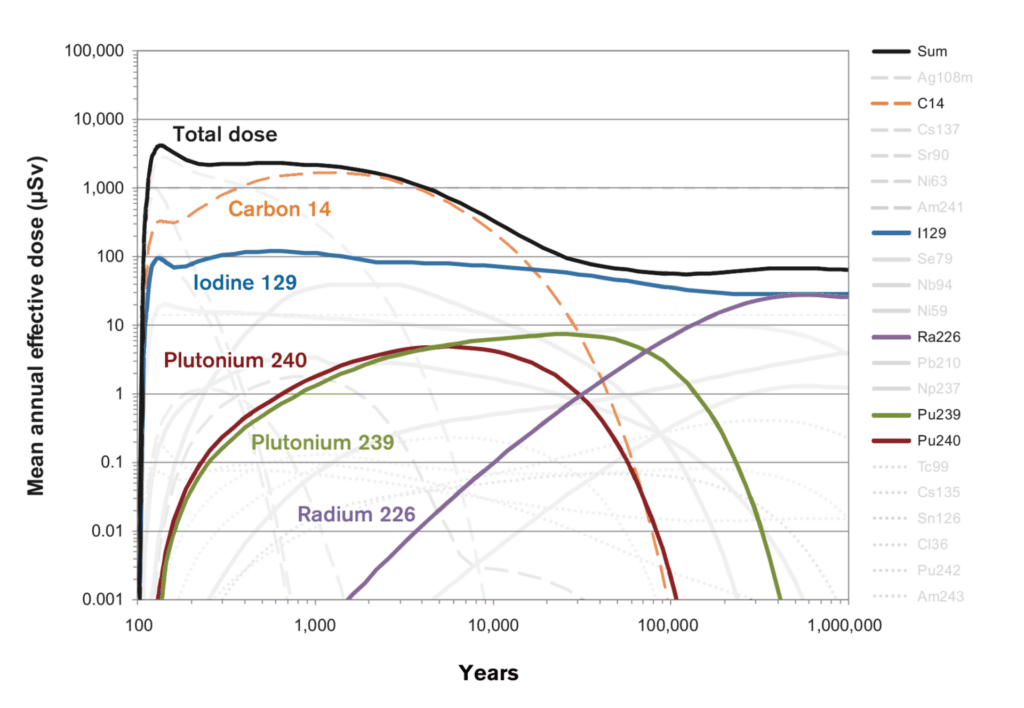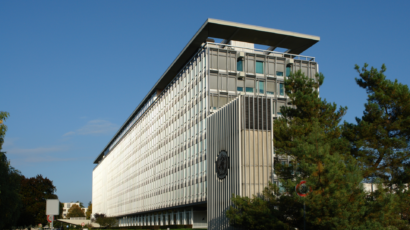Some fuels never learn. US Energy Department returns to costly and risky plutonium separation technologies
By Jungmin Kang, Masafumi Takubo, Frank von Hippel | September 14, 2022
 Starting in 1964, Idaho National Laboratory's Experimental Breeder Reactor II proved the concept of fuel recycling. The reactor was shut down in 1994 due to a lack of mission after the end of the US breeder program a decade earlier. The Energy Department is now supporting research, development, and demonstration of sodium-cooled reactors by several nuclear energy startups. (Credit Idaho National Laboratory via Flickr)
Starting in 1964, Idaho National Laboratory's Experimental Breeder Reactor II proved the concept of fuel recycling. The reactor was shut down in 1994 due to a lack of mission after the end of the US breeder program a decade earlier. The Energy Department is now supporting research, development, and demonstration of sodium-cooled reactors by several nuclear energy startups. (Credit Idaho National Laboratory via Flickr)
On July 17, the United Kingdom ended 58 years of plutonium separation for nuclear fuel by closing its Magnox nuclear fuel reprocessing plant at Sellafield. This leaves the UK with the world’s largest stock of separated power-reactor plutonium, 140 metric tons as of the end of 2020, including 22 tons separated for Japan. The UK is also second in the world only to Russia in the size of its overall inventory of separated plutonium with 119 tons, including 3.2 tons for weapons. Russia’s stock, 191 tons, is mostly “weapon-grade” separated for use in nuclear weapons during the Cold War, but the UK’s power-reactor plutonium is also weapon usable, and therefore also poses a security risk. The UK has no plan for how it will dispose of its separated plutonium. Its “prudent estimate” placeholder for the disposal cost is £10 billion ($12.6 billion).
One obvious way to get rid of separated plutonium would be to mix it with depleted uranium to make “mixed-oxide” (MOX) fuel energetically equivalent to low-enriched uranium fuel, the standard fuel of conventional reactors. Despite the bad economics, since 1976 France has routinely separated out the approximately one percent plutonium in the low-enriched uranium spent fuel discharged by its water-cooled reactors and recycled the plutonium in MOX fuel.
But both the UK and the US have had negative experiences with building their own MOX production plants.
In 2001, the UK completed a MOX plant, only to abandon it in 2011 after 10 years of failed attempts to make it operate. For its part, the US Energy Department, which owns almost 50 tons of excess Cold War plutonium, contracted with the French government-owned nuclear-fuel cycle company, Areva (now Orano), in 2008 to build a MOX fuel fabrication plant. But the United States switched to a “dilute and dispose” policy for its excess plutonium in 2017 after the estimated cost of the MOX plant grew from $2.7 billion to $17 billion.
Despite decades of failed attempts around the world to make separated plutonium an economic fuel for nuclear power plants, the United States Energy Department is once again promoting the recycling of separated plutonium in the fuel of “advanced” reactor designs that were found to be economically uncompetitive 50 years ago. At the same time, other countries—including Canada and South Korea, working in collaboration with the Energy Department’s nuclear laboratories—are also promoting plutonium separation as a “solution” to their own spent fuel disposal problems. These efforts not only gloss over the long history of failure of these nuclear technologies; they also fail to take into account the proliferation risk associated with plutonium separation—a risk that history has shown to be quite real.
Renewed advocacy for plutonium separation. As the UK finally turns its back on plutonium separation, the United States Energy Department is looking in the other direction. Within the Energy Department, one part, the Office of Defense Nuclear Nonproliferation, is struggling to dispose of excess Cold War weapons plutonium, as two others—the Office of Nuclear Energy and ARPA-E (Advanced Research Project Agency – Energy)—are promoting plutonium separation.
In 2020, the Office of Nuclear Energy put out a fact sheet about spent nuclear fuel. In this document, the fifth and last “fact” stated: “Used fuel can be recycled. … More than 90 percent of its potential energy still remains in the fuel, even after five years of operation in a reactor. The United States does not currently recycle used nuclear fuel but foreign countries, such as France, do. There are also some advanced reactor designs in development that could consume or run on used nuclear fuel in the future.”
The advanced reactor design the Office of Nuclear Energy refers to in its fact sheet is a plutonium breeder reactor that could, theoretically, convert the uranium 238 that constitutes more than 90 percent of the mass of spent fuel into plutonium and fission it—all of that over many recycles and hundreds of years.
In fact, the Energy Department’s Office of Nuclear Energy is promoting sodium-cooled reactor designs based on the Idaho National Laboratory’s Experimental Breeder Reactor II, which was shut down in 1994 due to a lack of mission after the end of the US breeder program a decade earlier. The Energy Department’s office is now supporting research, development, and demonstration of sodium-cooled reactors by several nuclear energy startups. Among them is Bill Gates’ Terrapower, to which the department has committed as much as $2 billion in matching funds to build a 345-megawatt-electric sodium-cooled prototype reactor—called Natrium (sodium in Latin)—in the state of Wyoming. One of Wyoming’s current senators, John Barrasso, is a leading advocate of nuclear power and could become chair of the Senate Committee on Energy and Natural Resources if the Republicans take control of the upper chamber in the elections this fall.
Terrapower insists Natrium is not a plutonium breeder reactor and will be fueled “once through” with uranium enriched to just below 20 percent and its spent fuel disposed of directly in a deep geologic repository, without reprocessing. Natrium, however, is set to use, initially at least, the same type of fuel used in Idaho’s Experimental Breeder Reactor II. The Energy Department maintains that this spent fuel cannot be disposed of directly because the sodium in the fuel could burn if it contacts underground water or air. On that basis, the Idaho National Laboratory has been struggling for 25 years to treat a mere three tons of spent fuel from the Experimental Breeder Reactor II using a special reprocessing technology called “pyroprocessing.” In pyroprocessing, the fuel is dissolved in molten salt instead of acid, and the plutonium and uranium are recovered by passing a current through the salt and plating them out on electrodes. In 2021, Terrapower stated that it plans to switch later to a fuel for Natrium that does not contain sodium but then received in March 2022 the largest of eleven Energy Department grants for research and development on new reprocessing technologies.
Liquid-sodium-cooled reactor designs date back to the 1960s and 1970s, when the global nuclear power community believed conventional power reactor capacity would quickly outgrow the available supply of high-grade uranium ore. Conventional reactors are fueled primarily by chain-reacting uranium 235, which comprises only 0.7 percent by weight of natural uranium. Because of this low percentage, nuclear power advocates focused on developing plutonium “breeder” reactors that would be fueled by chain-reacting plutonium produced from the abundant but non-chain-reacting uranium 238 isotope, which constitutes 99.3 percent of natural uranium. (Liquid-sodium-cooled reactors are sometimes called “fast-neutron reactors” because they utilize fast neutrons to operate. Sodium was chosen as a coolant because it slows neutrons less than water. Fast neutrons are essential to a plutonium breeder reactor because the fission of plutonium by fast neutrons releases more excess secondary neutrons whose capture in uranium 238 makes possible the production of more plutonium than the reactor consumes.)
Large programs were launched to provide startup fuel for the breeder reactors by reprocessing spent conventional power-reactor fuel to recover its contained plutonium.
The growth of electrical power production slowed dramatically worldwide in the 1970s, however. In the United States, the annual growth rate went from an average of 6.6 percent during the period 1920-70 to 1.9 percent during 1970-2020. Had the pre-1970 growth rate persisted as US electric utilities expected, US electricity production would have been 11 times larger in 2020 than it was. A similar pattern happened globally with 8 percent average growth in 1920-70 and 3.2 percent in 1970-2020.
Because of the less-than-expected demand for electricity, the growth of nuclear power slowed and then stopped. Declining construction rates drove capital costs for new nuclear power plants higher in most countries, while costs of natural gas-fired, wind, and photovoltaic power plants plunged. Liquid sodium-cooled breeder reactors proved even more costly than conventional water-cooled reactors. Only a few prototypes were built and then mostly abandoned. In 2020, the Organisation for Economic Co-operation and Development’s Nuclear Energy Agency estimated that sufficient low-cost uranium would be available to fuel existing conventional reactor capacity for more than a century.
Zombie plutonium-separation programs. Even though separated plutonium has morphed from the nuclear fuel of the future into a disposal problem, civilian plutonium separation continues in several countries, notably France, Japan, and Russia. It is also being advocated again by the offices within the US Energy Department that fund research and development on nuclear energy.
Russia still has an active breeder reactor development program, with two operating liquid sodium-cooled prototypes—only one of them plutonium fueled—plus a small, liquid, lead-cooled prototype under construction. But Russia has already separated 60 tons of power-reactor plutonium and has declared as excess above its weapons needs approximately 40 tons of weapon-grade plutonium. These 100 tons of separated plutonium would be enough to provide startup fuel for five years for six full-size breeder reactors.
China and India have breeder reactor prototypes under construction, but their breeders are suspected of being dual-purpose. In addition to their production of electric power, the weapon-grade plutonium produced in uranium “blankets” around the breeder cores is likely to be used for making additional warheads for their still-growing nuclear arsenals.
France and Japan require their nuclear utilities to pay for reprocessing their spent fuel and for recycling the recovered plutonium in MOX fuel, even though both countries have known for decades that the cost of plutonium recycling is several times more than using low-enriched uranium fuel “once through,” with the spent fuel being disposed of directly in a deep geological repository.
Claimed benefits of reprocessing. Advocates of plutonium recycling in France and Japan justify their programs with claims that it reduces uranium requirements, the volume of radioactive waste requiring disposal, and the duration of the decay heat and radiotoxicity of the spent fuel in a geologic repository. These benefits are, however, either minor or non-existent. First, France’s plutonium recycling program reduces its uranium requirements by only about 10 percent, which could be achieved at much less cost in other ways, such as by adjusting enrichment plants to extract a higher percentage of the uranium 235 isotopes in natural uranium. Second, with proper accounting, it is not at all clear that recycling produces a net reduction in the volume of radioactive waste requiring deep geological disposal. Third, the claimed heat reduction, if realized, could reduce the size of the repository by packing radioactive waste canisters more closely. But this is not significant because, with the currently used reprocessing technology, americium 241, which has a 430-year half-life and dominates the decay heat from the spent fuel during the first thousand years, remains in the reprocessed waste.
Claims of the reduced toxicity of reprocessed waste turn out to be false as well. For decades, France’s nuclear establishment has promoted continued reprocessing in part out of hope that, after its foreign reprocessing customers did not renew their contracts, it could sell its plutonium recycling technology to other countries, starting with China and the United States. But, with the notable exception of the canceled US MOX plant, these efforts so far have not materialized, and the willingness of the French government to continue funding its expensive nuclear fuel cycle strategy may be reaching its limits.
In 2006, France’s parliament passed a Planning Act on radioactive materials and wastes requiring “reduction of the quantity and toxicity of radioactive waste … notably by processing spent fuel and by processing and conditioning radioactive waste.” The act required a pilot facility for the “transmutation” (fissioning) of the plutonium and other transuranic elements accumulating in its spent MOX fuel to be completed by the end of 2020. In 2012, France’s nuclear research agency, the Commissariat à l’Énergie Atomique (CEA), which had shut down its failed 1,200 megawatt-electric sodium-cooled fast breeder demonstration reactor called Superphénix in 1998, came back with a proposal that the pilot plant becomes a new 600 megawatt-electric sodium-cooled reactor that would be called ASTRID (Advanced Sodium Technological Reactor for Industrial Demonstration). In 2019, however, after spending about $800 million in design studies, France’s government, citing the “current energy market situation,” decided not to proceed with the ASTRID project—at least not “before the second half of this century.”
In the United States, however, advocates of sodium-cooled reactors have obtained congressional backing—at least temporarily. In 2018, following efforts led by the two senators from Idaho, Congress mandated that the Energy Department examine the construction of a new sodium-cooled reactor—later named the Versatile Test Reactor—to test reactor materials and fuels for a possible new generation of these reactors. The legislation required the reactor to start operating by the end of 2025. The Energy Department’s Idaho National Laboratory proposed a scaled-up version of its shut-down Experimental Breeder Reactor II with an estimated cost of $2.6 to 5.8 billion. The Energy Department chose General Electric-Hitachi to build the reactor, which then proposed to partner with Bill Gates’ Terrapower. After the Energy Department’s Office of Nuclear Energy awarded Terrapower up to $2 billion to build the Natrium reactor—which would be very similar to the Versatile Test Reactor—by 2028, the department deferred the decision to build the latter reactor until 2027. Nevertheless, the Energy Department requested $145 million for the Versatile Test Reactor in its fiscal year 2022 budget. Congress provided no funding, however.
Proliferation danger. Aside from the waste of taxpayer money, there is one major public-policy objection to plutonium separation: Plutonium can be used to make a nuclear weapon. The chain-reacting material in the Nagasaki bomb was six kilograms of plutonium, and the fission triggers of virtually all nuclear warheads today are powered with plutonium. Reactor-grade plutonium is weapon-usable, as well.
In the 1960s, however, blinded by enthusiasm for plutonium breeder reactors, the US Atomic Energy Commission—the Energy Department’s predecessor agency—promoted plutonium worldwide as the fuel of the future. During that period, India sent 1,000 scientists and engineers to Argonne and other US national laboratories to be educated in nuclear science and engineering. In 1964, India began to separate plutonium from the spent fuel of a heavy-water research reactor provided jointly by Canada and the United States. Ten years later, in 1974, India used some of that separated plutonium for a design test of a “peaceful nuclear explosive,” which is now a landmark in the history of nuclear weapon proliferation.
Immediately after India’s nuclear test, the US State Department checked whether any other countries might be pursuing nuclear weapons via nominally civilian plutonium programs. The Department found that Brazil, Pakistan, South Korea, and Taiwan—all under military dictatorships at the time—had contracted for reprocessing equipment from French or German companies. Forceful US interventions with the French and German governments helped prevent those contracts from being fulfilled.
In the United States, the government concluded that neither breeder reactors nor spent fuel reprocessing could compete economically with water-cooled reactors fueled by once-through low-enriched uranium fuel. Subsequently, the US government decided to end funding for both programs in the late 1970s and early 1980s, and, with no government funding, the private sector also lost interest in the programs.
False environmental claims for reprocessing. Since the 1980s, advocates of reprocessing and plutonium recycling and fast neutron reactors in the Energy Department’s Argonne and Idaho National Laboratories have promoted them primarily as a strategy to facilitate spent fuel disposal.
The George W. Bush administration, which came to power in 2001, embraced this argument because it saw the impasse over siting a spent fuel repository as an obstacle to the expansion of nuclear power in the United States. To address the proliferation issue, the Bush Administration proposed in 2006 a “Global Nuclear Energy Partnership” in which only countries that already reprocessed their spent fuel (China, France, Japan, and Russia) plus the United States would be allowed to reprocess the world’s spent fuel and extract plutonium. The recovered plutonium then would be used in the reprocessing countries to fuel advanced burner reactors (breeder reactors tweaked so that they would produce less plutonium than they consumed). These burner reactors would be sodium-cooled fast-neutron reactors because the slow neutrons that sustain the chain reaction in water-cooled reactors are not effective in fissioning some of the plutonium isotopes. After Congress understood the huge costs involved, however, it refused to fund the partnership.
In 2001, the Argonne National Laboratory’s nuclear energy group informed an energy policy review group led by US Vice President Dick Cheney that the pyroprocessing technology the laboratory had developed to reprocess the fuel from Idaho’s Experimental Breeder Reactor II was “proliferation-resistant.” On that basis, the administration authorized the Argonne and Idaho national laboratories to share the technology with the South Korea Atomic Energy Research Institute. In 2009, however, a study by safeguards experts from six different Energy Department laboratories, including Argonne, concluded that pyroprocessing is not significantly more proliferation-resistant than conventional reprocessing. US attempts to end the joint US-South Korea research and development program on pyroprocessing led to difficult negotiations with South Korea that have not yet been resolved.
Plutonium and the geological disposal of spent fuel. Despite the unfavorable economics, the idea of separating and fissioning the plutonium in spent fuel has been kept alive in the United States and some other countries in part by continuing political and technical obstacles to siting spent fuel repositories. Proponents of reprocessing have managed to keep their governments’ attention on plutonium because it is a long-lived radioelement, a ferocious carcinogen—if inhaled—and has fuel value if recycled.
But detailed studies have concluded that plutonium makes a relatively small contribution to the long-term risk from a spent fuel geologic repository for spent fuel from commercial power reactors. Plutonium has relatively low solubility in deep groundwater, which makes it less mobile in the environment and slow to reach the surface. (One notable exception to this slow mobility is a hypothetical scenario that might occur in a volcanic area such as Nevada, where an eruption through a repository could disperse some of its radioactivity into the air to be inhaled by people downwind.) Moreover, plutonium is not concentrated in the food chain and, even if it were ingested, only about one percent of it would be absorbed into the body from the gut.
As a cumulative result of all of these barriers, the doses to humans through the food chain from plutonium caused by a leaking repository have been found to be minor in comparison to the doses from more water-soluble, long-lived radioisotopes. Calculations by SKB, Sweden’s nuclear waste management company, found that the long-term hazard from spent fuel is dominated first by carbon 14 (with a half-life of 5,700 years) produced through neutron absorption by atmospheric nitrogen trapped in fuel; then by the fission product iodine 129 (16 million-year half-life); and finally by radium 226 (which has only a 1,600-year half-life but is a decay product of uranium 238, which has a 4.5 billion-year half-life). (See figure.)[1]

The SKB results are consistent with the conclusions of a massive five-year study by the National Academy of Sciences on separation and transmutation technologies for nuclear waste commissioned by the Energy Department in 1991. That study, which was completed in 1996, found that “none of the [repository] dose reductions seem large enough to warrant the expense and additional operational risk of transmutation.”
These risk assessments are theoretical, but they are based on real-world experience with the movement of radioisotopes through the environment.
The main source of that experience is from the large quantities of fission products and plutonium lofted into the stratosphere by the fireballs of megaton-scale atmospheric nuclear tests between 1952 and 1980. During that period, the Soviet Union, the United States, China, the United Kingdom, and France injected into the stratosphere a total of about eight tons of fission products and 3.4 tons of plutonium—comparable to the quantities in a few hundred tons of spent light water reactor fuel. These radioisotopes returned to earth as global radioactive “fallout.”
The UN Scientific Committee on the Effects of Atomic Radiation (UNSCEAR) found that the total dose from the plutonium in the fallout was relatively small, with the most important contribution being due to inhalation on the plutonium’s way to the ground. Once on the ground, UNSCEAR estimated that the doses from ingestion of the plutonium would be relatively small. It estimated the summed effective dose commitment to the global population of the ingested plutonium at about 440 person-grays. For comparison, in 2000, UNSCEAR estimated the effective whole-body dose to future generations over 10,000 years from iodine 129 (16 million-year half-life) released into the atmosphere as a result of France’s reprocessing of about 64 tons of spent fuel during 1995-97 would result in a cumulative population dose of 123 person-grays. As of 2019, France had reprocessed cumulatively 34,000 tons of spent fuel at La Hague, which would scale this dose estimate to 64,000 person-grays.
Because studies suggest the hazards from plutonium in a spent fuel repository may be comparable to those from radium being released from a deep-underground uranium deposit, the attempts by proponents of reprocessing and fast-neutron reactors to emphasize the health and environmental risks of plutonium in spent fuel repositories have been counterproductive for the nuclear power industry.
In addition to the proliferation danger dramatized by the case of India, plutonium separation also brings with it a danger of a massive accidental radioactive release during reprocessing. The world’s worst nuclear accident before Chernobyl involved the Soviet Union’s first reprocessing plant for plutonium production, in 1957.
Some reprocessing advocates argue that, in the future, the plutonium in spent fuel directly disposed of deep underground might be mined to make nuclear weapons. This is a legitimate concern but the tradeoffs are complex: Reducing the danger of future proliferation by removing the plutonium from spent fuel before burial increases nuclear proliferation and terrorism risks today.
Gullible governments. Nearly half a century after India conducted its first nuclear test in 1974 with assistance provided inadvertently by Canada and the United States, both countries’ governments seem to have forgotten about the proliferation risk associated with spent fuel reprocessing. Today, advocates of fast-neutron breeder or burner reactors are pitching again the same arguments—used before the test—to gullible governments that seem unaware of the history of this issue. This ignorance has created problems for Canada’s nonproliferation policy as well as that of the United States.
In Canada, a UK startup, Moltex, has obtained financial support from federal and provincial governments by promising to “solve” Canada’s spent fuel problem. Its proposed solution is to extract the plutonium in the spent fuel of Canada’s aging CANDU (CANada Deuterium Uranium) reactors to fuel a new generation of molten-salt-cooled reactors. The Moltex company also proposes to make Canada an export hub for its reactors and small reprocessing plants.
In South Korea, the Korea Atomic Energy Research Institute, with support from Energy Department’s Argonne and Idaho National Laboratories, has similarly been campaigning to persuade its government that pyroprocessing spent fuel and fissioning plutonium in sodium-cooled reactors would help solve that country’s spent fuel management problem.
It is time for governments to learn again about the risks involved with plutonium separation and to fence off “no-go zones” for their nuclear energy advocates, lest they unintentionally precipitate a new round of nuclear-weapon proliferation.
Notes:
[1] Carbon 14 and iodine 129 are difficult to capture during reprocessing and therefore are routinely released into the atmosphere and ocean by France’s reprocessing plant at La Hague. Also, had the uranium 238 in the spent fuel not been mined, its decay product, radium 226, would have been released within the original uranium deposit. So, even though some reprocessing advocates join with nuclear power critics in amplifying the hazards of plutonium and other transuranic elements in underground radioactive waste repositories, they generally omit comparisons with reprocessing hazards (in the case of reprocessing advocates) or with natural uranium deposits (in the case of repository opponents).
Together, we make the world safer.
The Bulletin elevates expert voices above the noise. But as an independent nonprofit organization, our operations depend on the support of readers like you. Help us continue to deliver quality journalism that holds leaders accountable. Your support of our work at any level is important. In return, we promise our coverage will be understandable, influential, vigilant, solution-oriented, and fair-minded. Together we can make a difference.


















Just posted the following comment under Siegfried Hecker’s article which says Putin has destroyed “the basis for the entire global nuclear order” by his invasion of Ukraine: The fact that scientists, supposedly our smartest folks?, never envisioned such an event as war — apparently did not realize that wars will continue to occur again and again in the life of nuclear reactors AND NUCLEAR WASTE! — shows that scientists should not have ever been the decision makers. The moral of Putin’s “destroying the entire global nuclear order” is 1.) the whole atomic era has been a tragic mistake and should… Read more »
Scientists were NOT the decision-makers! Even while with one hand beginning the initiation of the United Nations, America, Truman to be specific, was intent (politically) on having the first atomic weapon, and in the rush to be able to have some of the war with Japan still in progress in order to be able to “demonstrate” it, every available scientist was put to work in the crash-course called The Manhattan Project. Many scientists ended up regretting that work. This entire weapons development project was a product of the male mind, in secret in order to, among other issues, prevent public… Read more »
Your conclusions in this article are a bunch of malarkey. Reprocessing or recycling of the spent fuel from the most common class of civilian-electricity-generating or power reactor design, the LWR, (with examples being the PWR or BWR) recovers reactor grade plutonium (as defined since 1976). Reactor grade, 7% or more Pu-240. The physical mixture of isotopes in reactor-grade plutonium make it extremely difficult to handle and form and therefore explains its undesirability as a weapon-making substance. Maximum probable theoretical yield would be bordering on a fizzle explosion of the range 0.1 to 2 kiloton in a Fat Man type device.